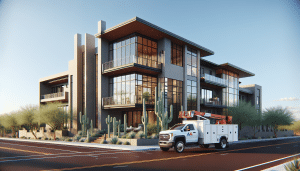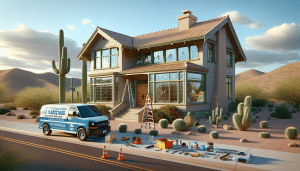Welcome to our blog at Arizona Window Company! If you’re a homeowner contemplating whether to go for retrofit windows or a full replacement, you’ve landed at the right place. We understand that the decision can be overwhelming. This article aims to break down the differences, benefits, and considerations, helping you make the best choice for your home.
Contents
Understanding Retrofit Windows
Retrofit windows, also known as insert windows, are designed to fit inside your existing window frame. This makes them a popular choice for homeowners looking to upgrade their windows without the hassle of removing exterior materials. Retrofit windows are less invasive than a full replacement and are usually quicker to install.
The primary advantage of retrofit windows is that they preserve the original window trim and siding, which can be a significant time and cost saver. However, they may not be suitable for every home, especially older homes with deteriorating frames.
For instance, if your current windows are in good structural condition but lack energy efficiency, retrofitting can be an excellent solution. This approach allows you to benefit from modern window technology without the mess and expense of a full-scale renovation.
In summary, retrofit windows can offer a great balance between functionality and aesthetics, but they are only as good as the existing frames they fit into.
The Benefits of Full Replacement Windows
Full replacement windows involve removing the entire existing window down to the studs of the home. This option offers many advantages for homeowners, particularly when dealing with older or damaged windows. For one, a full replacement allows for better insulation and energy efficiency, as the new windows will perfectly fit the openings.
Replacing windows in their entirety also gives you the chance to update the overall look of your house. Whether you’re seeking a more modern appearance or a different window style, a full replacement provides a blank canvas to execute your vision.
Furthermore, with a full Window Replacement, any underlying structural issues, such as damage to the frame or moisture infiltration, can be identified and repaired. This ensures the longevity and performance of your new windows.
However, it’s important to note that full replacements demand more time, labor, and materials, making them generally more expensive than retrofit installations.
Cost Comparison
Understanding the financial implications of both retrofit and full window replacements is crucial. Budget often plays a significant role in decision-making, and knowing what to expect can help you plan accordingly.
Retrofit windows tend to be more cost-effective due to the reduced labor and materials required. They can be installed quickly, often within a day, minimizing disruptions to your daily life. On the other hand, full replacements involve a more intensive process, which can lead to higher labor costs and increased material expenses.
While the upfront costs for full replacements are generally higher, they can offer better long-term value. The improved energy efficiency and potential for resolving hidden issues can lead to savings on your energy bills and long-term maintenance costs.
In contrast, if budget constraints are a significant concern, retrofitting can provide an effective solution that enhances your home’s aesthetics and performance without breaking the bank.
Timeline and Installation Process
The timeline and complexity of installing new windows can vary significantly between retrofit and full replacements. For retrofitting windows, the process is usually quicker and less invasive. Since the existing frame remains intact, the installation experts can typically complete the job within a day or two.
When it comes to full window replacements, expect a longer timeline. Removing the old windows, addressing any structural issues, and installing the new windows can take anywhere from several days to a week or more, depending on the number of windows and the extent of replacements required.
While retrofit installations cause minimal disruption to your home life, full replacements may necessitate some adjustments to your schedule. However, the long-term benefits often outweigh the temporary inconveniences.
Our team at Arizona Window Company commits to delivering quality work swiftly and efficiently, but it’s essential to recognize the time differences between the two methods.
Energy Efficiency
Energy efficiency is a crucial factor in choosing new windows. Retrofitting can significantly improve your home’s energy efficiency if your existing frames are in good condition. The new windows will provide better insulation, reducing energy loss and, in turn, your utility bills.
Full window replacements often offer the best results in terms of energy efficiency. By replacing the entire window unit, you can be assured that there are no leaks or gaps that might compromise the insulation. Modern replacement windows come with advanced features such as double or triple glazing, low-E coatings, and argon gas fills that can substantially enhance energy performance.
Regardless of which option you choose, upgrading your windows is an excellent step towards a more energy-efficient home. However, it’s worth noting that full replacements typically lead to more significant energy savings.
Both options can contribute to a greener home, but the overall impact on energy efficiency will largely depend on the condition of your current windows and the specifics of the new ones.
Aesthetic Considerations
Both retrofit and full replacement windows offer opportunities to enhance the visual appeal of your home. Retrofitting allows you to maintain the existing window style and exterior appearance, making it ideal for homes with unique architectural features that you wish to preserve.
Full replacements, however, give you more freedom to alter the look and style of your windows. This can be particularly appealing if you’re aiming to modernize your home or prefer a different window arrangement.
With retrofitting, the new windows are designed to fit within the existing frames, limiting the scope for significant changes. Nonetheless, you can still select from a variety of designs and materials to refresh your home’s appearance.
Full window replacements provide the broadest range of aesthetic options. From choosing different frame materials to entirely new window configurations, the possibilities are virtually limitless.
Resale Value
Upgrading your windows can significantly enhance your home’s resale value. Both retrofit and full replacement windows can offer good returns on investment, yet they impact home value differently.
Retrofit windows can appeal to potential buyers by offering upgraded features without substantial alterations to the home’s original design. They demonstrate that the property is well-maintained and up-to-date with modern efficiency standards.
On the other hand, full window replacements are usually more attractive to buyers. New windows that replace outdated or damaged ones can be a strong selling point, indicating a deeper level of care and investment in the property.
Both options can boost your home’s marketability, but full replacements generally have a broader appeal and can justify a higher asking price.
Maintenance Requirements
Maintenance is an essential consideration when choosing between retrofit and full replacement windows. Retrofit windows inherit the existing frame’s condition, which is crucial. If the frame is in excellent shape, maintenance will be minimal. You’ll only need to care for the new glazing and sash.
Full replacement windows often come with advanced, low-maintenance materials. Vinyl, fiberglass, and aluminum are popular choices for their durability and ease of care. With these materials, you may find that your new windows require very little maintenance compared to older ones.
While retrofit windows might need periodic checks to ensure the existing frame remains in good shape, full replacements generally require less frequent maintenance due to the newer materials and installation techniques.
In both cases, proper initial installation and high-quality materials are key to reducing future maintenance needs.
Environmental Impact
The environmental impact of your window upgrade is another factor worth considering. Retrofitting windows can be a greener option as it involves reusing the existing frames and materials, thereby reducing waste. This approach aligns well with sustainable practices aimed at minimizing environmental footprints.
Full replacements, although creating more immediate waste, can also be environmentally beneficial in the long term. The increased energy efficiency of modern windows can lead to significant reductions in home energy consumption, thereby lowering your carbon footprint over time.
Additionally, many new window options incorporate eco-friendly materials and manufacturing processes, further enhancing their environmental appeal.
Ultimately, both retrofitting and full replacements offer eco-conscious benefits, with the choice largely depending on your current window conditions and overall sustainability goals.
Making Your Decision
Choosing between retrofit and full replacement windows comes down to multiple factors, including your budget, current window condition, and long-term goals. If your existing frames are in good shape, retrofitting can provide a cost-effective and efficient upgrade.
However, if you face structural issues or wish to significantly enhance your home’s energy efficiency and appearance, a full replacement might be the better choice. Consider your specific needs, future plans, and the potential return on investment when making your decision.
Both options can significantly improve your home’s comfort, efficiency, and aesthetics. Consulting with a window expert can provide further insights tailored to your unique situation.
At Arizona Window Company, we’re here to help you navigate these choices and ensure you receive the best solution for your home.
Ready to upgrade your home with new windows? Contact Us by phone # 480-526-4456 or Request a Free Quote.




